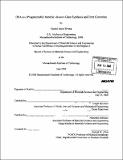DNA as a programmable material : de novo gene synthesis and error correction
Author(s)
Hwang, Samuel James
DownloadFull printable version (13.44Mb)
Alternative title
Deoxyribonucleic acid as a programmable material
Other Contributors
Massachusetts Institute of Technology. Dept. of Materials Science and Engineering.
Advisor
Joseph Jacobson.
Terms of use
Metadata
Show full item recordAbstract
Deoxyribonucleic acid (DNA), the polymeric molecule that carries the genetic code of all living organisms, is arguably one of the most programmable assembly materials available to chemists, biologists, and materials scientists. Scientists have used DNA to build many different structures for various applications in disparate areas of research from traditional biological applications to more recent non-biological applications. Although DNA isn't typically thought of as an assembly material by people not doing research in the area, the availability of decreasing cost synthetic oligonucleotides has led to advances in gene fabrication technology which in turn has enabled synthetic biology to flourish. Using DNA as a building material for small and large constructs of DNA is reliant on having effective gene synthesis techniques. Construction of synthetic DNA is limited by errors that pervade the final product. To address this problem, effective error correction methods are pivotal. Having extremely robust gene synthesis and error correction techniques will allow researchers to generate very large scale constructs potentially necessary in applications such as genome re-engineering.
Description
Thesis (S.M.)--Massachusetts Institute of Technology, Dept. of Materials Science and Engineering, 2008. Includes bibliographical references (leaves 42-43).
Date issued
2008Department
Massachusetts Institute of Technology. Department of Materials Science and EngineeringPublisher
Massachusetts Institute of Technology
Keywords
Materials Science and Engineering.